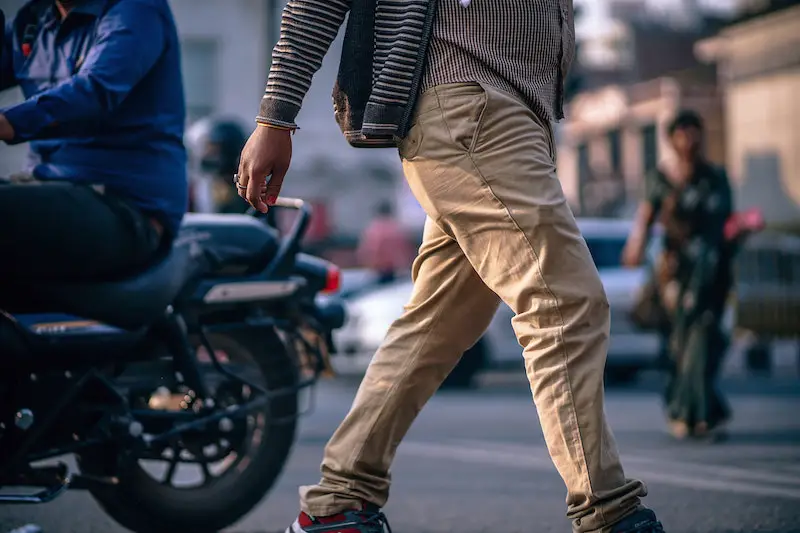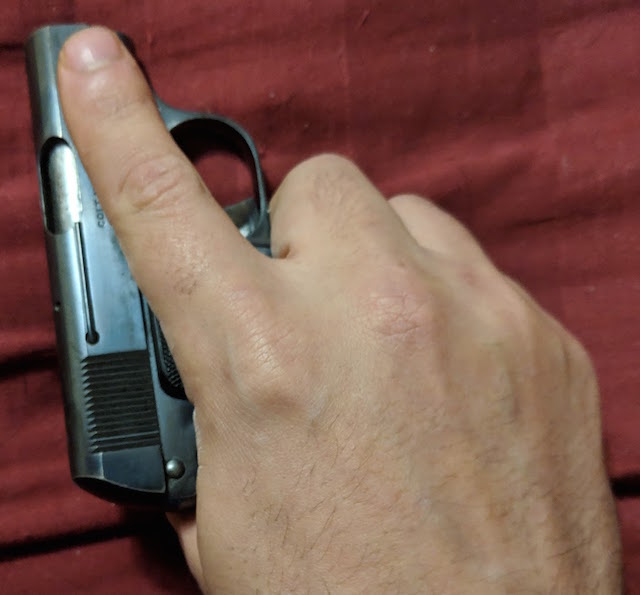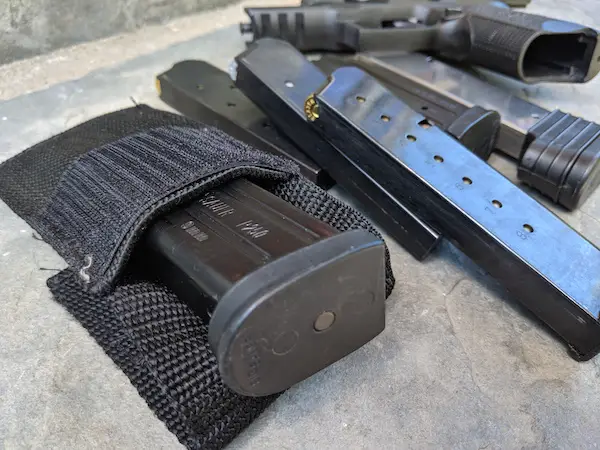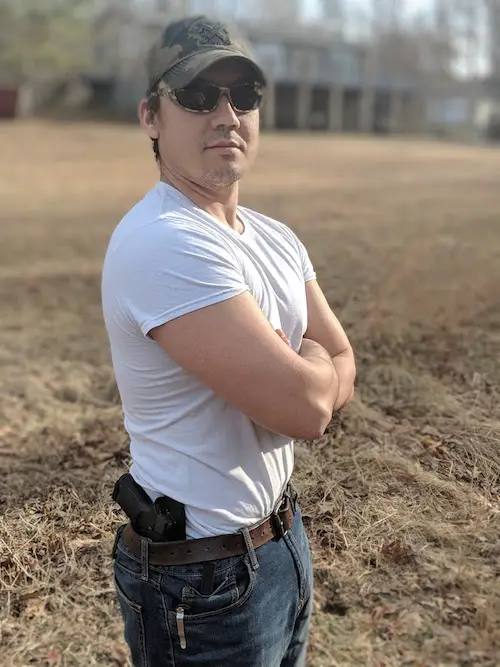While at the gas station a few weeks ago, I noticed a woman was carrying concealed (not very well) and I inquired about what her weapon of choice was. Turns out she was an off duty officer, and after a few tense moments and idle comments, we parted ways. However, the situation got me thinking about what I would do in a similar situation.
So, assuming you are not doing anything illegal, and are licensed to carry concealed, what should you do if someone asks if you are carrying a gun?
- Ask the person to identify themselves.
- If possible, and if threatened, increase the distance between you and them.
- Reply accordingly based on persons’ identity.
- Extract yourself from the situation.
- Assess your method of carrying concealed to prevent future inquiries.
I’ll cover each of the 5 steps in depth below, and why this is my preferred method of navigating this situation.
Table of Contents
1. Ask The Person To Identify Themselves
The first step when someone asks whether you are carrying a firearm is to answer their question with a question. This accomplishes several things at once. A would-be attacker, or anyone for that matter, may fumble over their words. Doing so can buy you valuable time while their brain processes an acceptable answer to your question.
This can be something casual like, “I’m sorry, do I know you?” or “Have we met?” You can also take a more authoritative tone, with something along the lines of “Are you a police officer?” Ultimately, the goal is to identify if the person is a member of law enforcement.
Assuming the person is not law enforcement, you can ask a follow-up question to assess their intentions. If you are in a restaurant, the owner may inquire because of uneasy guests, or because he caught a glimpse of your firearm as you bent over to sit down. In this instance, he is likely inquiring to tell you of the restaurants’ policy about firearms.
However, in the aforementioned scenario, I was asking the woman at the gas station simply out of curiosity. This is the scenario where you need to gauge intent, and the most caution is required. This is particularly true if you are isolated, and could be perceived as a target.
2. Retreat To A Safe Distance
As you are asking your questions, and discerning the persons’ intent, you should simultaneously be putting distance between you and them. Now is a good time to key in on their body language. As you retreat, are they advancing? I will use my scenario from above as an example. If approached at a gas station pump about my firearm, I would, without turning my back, make my way toward the front of my truck.
You may have heard of the 21-foot rule. If not, it states that a person with a knife can close a distance of 21 feet before you are able to un-holster and discharge your weapon accurately. Given the fact that you are carrying concealed, the distance they can cover likely increases. Carrying concealed also means it typically takes longer to un-holster your weapon.
In my example, I stated that I would move toward the front of my vehicle. This accomplishes 3 goals. First, I am increasing the distance between myself and a potential threat. Second, I could easily sidestep in front of my vehicle giving me cover should the would-be attacker also have a firearm. Third, by sidestepping, it also adds an obstacle for the perpetrator to navigate. Giving me further time to increase the distance and/or draw, aim, and fire my weapon.
3. Reply As Needed
We all know the old adage, “honesty is the best policy.” While this may hold true in a lot of situations, there’s really no reason for you to disclose that you are carrying a firearm. You could feign ignorance, which the female officer initially tried to do to me. She simply said, “I don’t know what you’re talking about.”
I’ve found the direct approach is the best method. Something along the lines of “It’s none of your business,” usually does the trick. This maintains any level of ambiguity you still have. It’s also usually a quick way to end a conversation. Which, gets you safely to the fourth step of extracting yourself from the situation.
Another method is to outright lie, and say “No.” I do not prefer this method, because you’re claiming to be unarmed. I’d rather deter a perpetrator with ambiguity than convince them I am a target, and be forced to use my weapon.
However, occasionally, you’ll come across another firearms enthusiast. This person will likely give you a wide berth, and bring up the weapon in a nonchalant manner. I thought I had made myself appear as non-threatening as possible, but something put the lady officer on alert. In any case, it’s at your discretion whether to tell a stranger, harmless or not, whether you’re carrying concealed.
4. Extract Yourself From The Situation
Let’s assume, the person continues their discussion or presses the issue. I had no ill intentions, but it was blatantly obvious the woman was carrying, and I was curious. I didn’t ask if, but rather, what she was carrying.
Look for a way to exit the conversation and the persons’ presence. This can be going inside the store to “pay” for your gas in my scenario. Whatever the situation, you’ll want to look for someplace that has other people. Someone looking to attack you likely won’t pursue you elsewhere.
Again, there’s no need to be honest. Make up a lie about meeting a friend if you have to. If the person refuses to let you leave, you always have access to your firearm. If you followed the first two steps, you have set yourself up for the highest chance of success should the need arise to use your weapon.
5. Assess Your Method Of Carrying
At this point, you’ve successfully navigated this little unpleasant interaction. Now you need to assess yourself to prevent this from happening in the future. Perhaps there was a certain action you performed that revealed your firearm. Can your firearm be seen because of a bulge or sweat outline – a.k.a. printing?
If you’ve decided in step 3 that the person is not a threat, and have entered into a cordial conversation about firearms, you should probably ask how the person knew you were carrying. After all, no one goes around just asking strangers if they are carrying a gun. Take this information, and evaluate your method of carrying.
Handling Law Enforcement
If the person identifies themselves as a police officer, I recommend asking them to verify this information. Ask them for their last name, a form of id, and a badge as proof of identification. Keep a sharp eye out as they reach for this information, to ensure they aren’t arming themselves. I doubt any attacker will voluntarily provide you any kind of personal information.
Politely explain, that you can “never be too careful” in this day and age. Once verified that they are indeed law enforcement, comply with their requests. Provide any documentation they require and do not be aggressive. However, if the person fails to provide you any documentation, do not feel bullied. Explain that you’d be more than happy to wait for a uniformed officer to arrive if they prefer.
Handling Private Property Establishments
I’ve found the best way to handle restaurants, coffee houses, and other private property establishments is to avoid any that are not firearm friendly. The legality of entering these establishments with a concealed weapon may vary from location to location.
However, if you find yourself in a situation where someone asks about your firearm, ask them to identify themselves. At that point, if they are an authority figure, they’ll likely identify themselves as the on-duty manager, owner, etc. If they do not immediately tell you their policy, feel free to inquire about their firearm policy.
Should firearms not be permitted, politely offer to pay for any service you may have received before leaving the establishment. Failure to do so may lead to trespassing charges, at the very least. Be polite, and don’t cause a scene. Firearm ownership is already under attack because of the crazy people out there who use firearms to commit heinous crimes. There’s no need to contribute to the firearm owner social stigma.
Parting Shots
Handling the awkward situation where a stranger asks if you are carrying a firearm takes finesse to navigate successfully. It is imperative to pay attention to your surroundings, in order to keep yourself safe. These situations are rarely the result of someone with nefarious purposes, however, you should always exercise caution. Follow the above steps, be respectful, and you should be fine.










